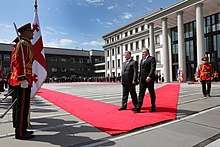State visit
A state visit is a formal visit by a head of state to a foreign country, at the invitation of the head of state of that foreign country, with the latter also acting as the official host for the duration of the state visit. Speaking for the host, it is generally called a state reception. State visits are considered to be the highest expression of friendly bilateral relations between two sovereign states, and are in general characterised by an emphasis on official public ceremonies.
.jpg)
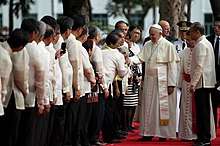
.jpg)
Less formal visits than a state visit to another country with a lesser emphasis on ceremonial events, by either a head of state or a head of government, can be classified (in descending order of magnitude) as either an official visit, an official working visit, a working visit, a guest of government visit, or a private visit.[1][2]
In parliamentary democracies, while heads of state in such systems of government may formally issue and accept invitations, they do so on the advice of their heads of government, who usually decides on when the invitation is to be issued or accepted in advance.
Queen Elizabeth II is "the most travelled head of state in the world," having made 261 official overseas visits and 96 state visits to 116 countries by the time of her Diamond Jubilee in 2012.[3] Although she is sovereign of each of the Commonwealth realms, in practice, she usually performs full state visits as Queen of the United Kingdom, while the relevant governor-general undertakes state visits for his or her respective country on the sovereign's behalf. However, the Queen has occasionally made some state and official visits representing one of her other Commonwealth realms.
Components of a state visit
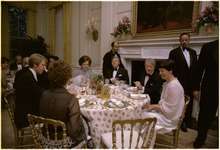
State visits typically involve some or all the following components (each host country has its own traditions):
- The visiting head of state is immediately greeted upon arrival by the host (or by a lesser official representative, if the two heads of state are to meet later at another location) and by his or her ambassador (or other head of mission) accredited to the host country.
- A 21-gun salute is fired in honor of the visiting head of state.
- The playing of the two national anthems by a military band. The guest country's anthem is usually played first.
- A review of a military guard of honour.
- The visiting head of state is formally introduced to senior officials/representatives of the host country and the hosting head of state is introduced to the delegation accompanying the visiting head of state.
- An exchange of gifts between the two heads of state.
- A state dinner, either white tie or black tie, is mounted by the hosting head of state, with the visiting head of state being the guest of honor.
- A visit to the legislature of the host country, often with the visiting head of state being invited to deliver a formal address to the assembled members of the legislature.
- High-profile visits by the visiting heads of state to host country landmarks such as laying a wreath at a military shrine or cemetery.
- The staging of cultural events celebrating links between the two nations.
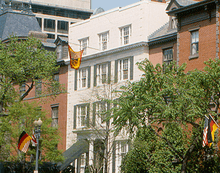
The visiting head of state is usually accompanied by a senior government minister, usually by a foreign minister. Behind the diplomatic protocol, delegations made up from trade organizations also accompany the visiting head of state, offer an opportunity to network and develop economic, cultural, and social links with industry leaders in the nation being visited. At the end of a state visit, the foreign head of state traditionally issues a formal invitation to the head of state of the nation being visited who at another time in the future, would pay a reciprocal state visit.
While the costs of a state visit are usually borne by state funds of the host country, most nations host fewer than ten state visits per year, with some as few as two. Most foreign heads of state will stay in the official residence of the head of state who is hosting the state visit, in a guest house reserved for foreign visitors, or in their own nation's embassy located in the foreign nation being visited.
State visits by well-known global leaders, such as Elizabeth II, the President of the United States or the Pope, often draw much publicity and large crowds. Occasionally, these include protesters.
State visits by country
Armenia
State visits to Armenia are held in the capital of Yerevan, with a welcoming ceremony usually being held at Zvartnots International Airport. Foreign heads of state are welcomed at the President's Residence while heads of government are welcomed at the Residence of the Prime Minister. These visits consist of the following components:
| Rank of visitor | State dinner | Arrival ceremony at the Prime Minister's Residence | Arrival ceremony at the President's Residence | Arrival ceremony at the airport | Exchange of diplomatic gifts | Meeting with religious leaders | Address to the National Assembly | |
|---|---|---|---|---|---|---|---|---|
| State visit | head of state | Yes | No | Yes | Maybe | Yes | Yes | Maybe |
| Official visit | head of government | Yes | Yes | No | Maybe | Maybe | Maybe | Maybe |
Since 1991, foreign leaders who embark on visits to Armenia have paid tribute to the victims of the Armenian Genocide at the Tsitsernakaberd complex.[4] During a visit to the complex, most leaders receive a tour of the museum, plant trees near the memorial, and lay wreaths at the eternal flame.
Belgium
A state visit in Belgium starts with an inspection of the troops in front of the Royal Palace of Brussels, whereafter the King and Queen have a private audience with the visiting head of state and his or her spouse. The first day of the state visit traditionally comes to a close with a state banquet at the Castle of Laeken, which is the official residence of the King of the Belgians.
It is customary to be awarded the Knight Grand Cross of the Order of Leopold during state visits.
Canada

The Governor General's Foot Guards, one of two household Foot Guards, take part in state and official visits to Ottawa. Arrival ceremonies take place at either Parliament Hill or Rideau Hall, where they will be received by the Prime Minister of Canada and the Governor General of Canada respectively. State visits also include a visit to the National War Memorial. The Office of Protocol coordinates the operational aspects of state and official visits to Canada and manages all events that are related to the visit. It also defines the protocol standards for state visits of heads of state and government.[5]
State and official visits by Canada are performed by the Monarch of Canada or a representative—the Governor General, a lieutenant governor, or another member of the Royal Family. The first state visit by Canada was to the United States in 1937, when the United States accorded the Governor General the equivalent status given to a visiting head of state.[6] However, the Governor General was not formally empowered to represent Canada for state visits until 1947, when the Letters Patent came into effect.[6]
Tours of Canada by the Monarch of Canada (and other members of the Royal Family) are not state/official visits, as the monarch conducts their royal tours in their capacity as the Canadian head of state, and not as a foreign head of state. Additionally, because the Canadian sovereign is shared with 15 other Commonwealth realms, state visits are not conducted between Canada and the other Commonwealth realms, with official visits performed by the realms' respective governor-general, or prime minister.
China, People's Republic of
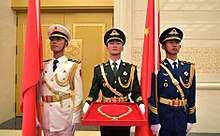
State arrival ceremonies in China take place at the East Court of the Great Hall of the People on Tiananmen Square in Beijing. The Guard of honour for the ceremony is provided by the Beijing Garrison Honor Guard with musical accompaniment provided by the Central Military Band of the People's Liberation Army of China.
As the military band plays the national anthems of the two countries, an artillery battery fires a 21-Gun Salute. After the band finishes its performance, the two leaders then inspect the guard of honour at the invitation of the guard commander. Following the inspection, both leaders embrace schoolchildren who wave flowers and the flags of both countries. At this time, the band performs a military march or folk song from the guest country. If a Prime Minister or Chancellor or Crown Prince visits China, the welcoming ceremony is held by the Premier. If a President, Governor-General or King visits, the welcoming ceremony is held by the President.
The People's Liberation Army (PLA) Honor Guard then marches off the square to the tune of the March of the Chinese People's Liberation Army. The ceremony ends with the marching band of the PLA performing an exhibition of military drill.[7]
During state visits, national awards are presented to visiting dignitaries, including the Order of Friendship. Since 1954, the State Protection Unit has provided motorcades for visiting dignitaries traveling from the airport to their meeting place.[8]
Czech Republic
The military welcome accorded to foreign leaders at Prague Castle are provided by troops of the Prague Castle Guard, Honor Guard of the Czech Armed Forces, the Czech Army Central Band, the Band of the Castle Guards and Police and units of the Prague Garrison Command.
France
.jpg)
State arrival ceremonies are held at either the Elysee Palace or Les Invalides, with the participation of the Infantry and Fanfare Band of the French Republican Guard Band and the 1st Infantry Regiment of the Republican Guard. The Vestibule d'Honneur (Hall of Honour) in the Elysee is where the President of France meets visiting dignitaries and holds bilateral meetings. Towards the end of the visit, the head of state or governments will give a speech at the Palais Bourbon to the Senate of France, and will hold meetings with members of parliament. Sometime during the state visit, the visiting dignitary will lay a wreath at the Tomb of the Unknown Soldier at the Arc de Triomphe.
Georgia
State visits in Georgia are held outside the Presidential Administration of Georgia in Tbilisi. Ceremonial honours are provided by the Honour Guard and the Band of the National Guard of Georgia. The band plays Georgian Army songs during the inspection of the honour guard. During the Presidency of Mikheil Saakashvili, the band played the March of the Preobrazhensky Regiment during state visits.
During state visits, dignitaries usually meet with the Prime Minister, Chairperson of Parliament, and the Catholicos-Patriarch of All Georgia separately from the president. State dinners are also held inside the presidential palace with officials from both countries present.
Germany
During state visits to Germany, honours are provided by the German Wachbataillon (Guard battalion) and the Staff Band of the Bundeswehr. An exception to this was on 3 May 2007 during the visit of French President Jacques Chirac to Berlin, during which the Franco-German Brigade provided the honors. Depending on the status of the guest, state ceremonies are either held at the Bellevue Palace or the Federal Chancellery Complex. In recent years, state visits have been marked with dignitaries paying homage at memorials such as the Berlin Victory Column, the Memorial to the Murdered Jews of Europe, and the Soviet War Memorial (Tiergarten).
During state visits, foreign dignitaries typically visit German federal states outside the capital. It this regard, a full honors ceremony is also held with the minister-president being the presiding officer.[9][10] In break with the traditional Berlin military protocol, chairs have since July 2019 been set up outside the Chancellery due to Chancellor Angela Merkel's unusual episodes of shaking and uneasiness during the honours ceremony. Currently, only Moldovan Premier Maia Sandu and Danish Prime Minister Mette Frederiksen have had to be received under this arrangement.[11]
India
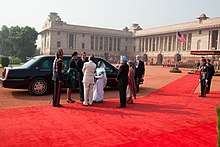
Foreign leaders are received at the Rashtrapati Bhavan in New Delhi during state visits. The dignitary first receives the salute from the President's Bodyguard (PBG), and the Tri-Services Guard of Honour. Heads of State is also given a 21-gun salute, with a 19-gun salute being to Heads of government. The massed bands and the commander of the guard of honour is chosen by a rotation between the Indian Army, Navy, and Air Force. In 2015, Wing Commander Pooja Thakur became the first female officer to lead the guard of honour for a foreign leader.[12] All military honours are organized by Section D of the Ministry of Defence.[13]
State banquets are also held for foreign dignitaries at the Rashtrapati Bhavan which are hosted by the President of India. Over 100 guests are invited to attend state banquets, including the Vice-President of India, the Prime minister of India, as well as government officials and leaders of the ruling party.
Israel
The President of the State of Israel, in his/her position as head of state, leads the welcoming events and is the official host of foreign leaders who visit Israel. A Guard of Honor made up of personnel of all the service branches of the Israel Defense Forces (IDF) are usually lined up at the main V.I.P terminal of Tel Aviv International Airport.
During some state visits, the itinerary has included a visit to the Yad Vashem memorial. There the leader, accompanied by the Prime Minister, will rekindle the Eternal Flame, and will also lay a wreath in memorial of the 6 million Jews who died in the holocaust.
Italy

When dignitaries arrive in the Italian capital of Rome, they are received in a short reception ceremony at the airport by the Head of the Diplomatic Ceremonial Office among other officials, who then briefly entertain the guest in the boardroom to allow the handling of airport formalities. Arrival honors for foreign dignitaries visiting Rome are held either at the Quirinal Palace (official residence of the President of the Italian Republic) or the Palazzo Chigi (official residence of the Prime Minister of the Italian Republic). During the ceremony, the guard of honor is provided by a military unit (most likely the Corazzieri and a selected ceremonial unit such as the Honour Company "Goito" from the 1° Regiment "Granatieri di Sardegna") and a supporting military band that performs 3 Ruffles and flourishes known as "Onori" ("Honors") prior to playing the national anthem of the dignitary's home country and Il Canto degli Italiani. In recent years, the Bersaglieri, the Carabinieri, and the Italian Navy have provided honor guards for the ceremony.
The rest of the day includes bilateral meetings, one on one conversations, a joint press conference, and a state dinner, where the exchange of gifts and the awarding of honors takes place. The next day sees the laying of wreaths at the Tomb of the Unknown Soldier in the Altar of the Homeland. All protocol events in the capital are organized by the State Ceremonial Office. In particular, the Ceremonial Office of the Ministry of Defense handles protocol related to the Italian Armed Forces, and the Diplomatic Ceremonial Office of the Ministry of Foreign Affairs handles protocol related to the diplomatic corps.[14]
Japan
.jpg)
Japan extends invitations for state visitors and official visitors aims to promote the friendship and relation between Japan and the country of the invitee.[15] In addition to state and official visits, the Japanese government also extends several other forms of invitations to visit the country.
The invitation of official practical visitors, practical visitors, and visitors to Japan's Ministry of Foreign Affairs aim to promote negotiations, to strengthen security and to be used for policy coordination, etc.
The invitation of ministers is an invitation extended to ministers from other countries, and aims to have them deepen their understanding of Japan and send information about Japan based on the knowledge obtained through invitations through conference, inspection, etc. with Japanese VIPs and experts.
The invitation of strategic practitioners is an invitation extended to certain members in certain positions or those who are expected to hold a certain leadership position in the future, in political, economic, governmental, academic, etc., in foreign countries or international organizations. It aims to promote understanding of Japan's various policies and fields such as culture and society, to facilitate the promotion of Japan's foreign policy through personal connections with Japanese experts, and to promote pro-Japan in the medium- and long-term through briefings with private experts, Japanese cultural experiences, and local visits.
| Visitor | Stay | Reception [16] | Talk with Emperor | Luncheon | Banquet | |
|---|---|---|---|---|---|---|
| State Visitor | Monarch, President, etc. [17] | Akasaka Palace [18] | Yes | Yes [19] | Luncheon with the prime minister | Banquet at the palace |
| Official Visitor | Prince, Prime Minister, etc. [20] | Akasaka Palace [18] | Yes | Yes [21] | Luncheon at the palace | Banquet with the prime minister |
| Official Practical Visitor | A person equivalent to a state visitor or an official visitor [22] | A strictly secured public accommodation | No | Yes [21] | No | No |
| Practical Visitor | A person equivalent to a state visitor or an official visitor [23] | A public accommodation | No | Yes/No [24] | No | No |
| Visitor to the Ministry of Foreign Affairs | The Secretary-General of the United Nations, etc. [25] | A public accommodation | No | No | No | No |
Kyrgyzstan

State visits are planned in accordance with the Ministry of Foreign Affairs one month in advance. Arrival ceremonies for state visits to Kyrgyzstan typically take place at Manas International Airport with the participation of the Honour Guard Battalion of the 701st Military Unit of the National Guard and the Band of the General Staff of the Armed Forces of Kyrgyzstan.[26] A wreath-laying ceremony is also held at Victory Square. A bilateral meeting, press conference, and state dinner are all held at the Ala Archa State Residence.
The Kyrgyz official welcoming group includes the Chairman of the Supreme Council, the Prime Minister, and the Minister of Foreign Affairs. The official morning breakfast reception takes place from 11:00 am to 3:00 pm. Arrival ceremonies are also held at the state residences all over the country.[27]
Mexico
State visits to Mexico City are held on a regular basis.[28] Arrival ceremonies are usually held at the National Palace, the president's workplace or at Mexico City International Airport. On certain occasions, a full honors ceremony with the participation of the National Guard's Presidential Guards Corps are held at Campo Marte, where the corps' two military police brigades are stationed.
.jpg)
The arrival ceremony begins with a platoon of National Guards presenting arms at the arrival of the state guest at the entrance of the National Palace, and after he/she arrives with the President of Mexico (and his First Lady if present) in the palace' south courtyard the NG's Presidential Guards honor guard company presents arms while the Representative Music Band of the Mexican Armed Forces plays the anthems of the two countries (the Himno Nacional Mexicano is always played first). Then the President of Mexico introduces members of his/her cabinet before the visiting dignitary introduces members of their delegation accompanying them on this visit. After this is done, the commander of the National Guard's honour guard company then delivers the following report to the dignitary:
- “With your permission Mr/Madam President of the United Mexican States, I am the commander of the honour guard of the (states dignitary's position) and I invite you to review the guard of honour present, sir/ma'am."
The president and the dignitary then inspect the guard, paying homage to the Mexican flag and the flag of the guest country along the way. The ceremony then ends and the two go into the palace to begin their bilateral meeting. The Campo Marte ceremony is similar in style to the palace ceremony with the main differences being a 21-gun salute, opening remarks, and the military parade being added to the program. The unit responsible currently for the 21-gun salute is the State Honors Artillery Battery, coming under the 1st Artillery Battalion (Separate) of the 1st Army Corps.
Moldova
The State Diplomatic Protocol (SDP) of the Ministry of Foreign Affairs and European Integration of Moldova organizes activities concerning state visits to the Moldovan capital of Chisinau.[29] All state arrival ceremonies take place at the Presidential Administration or the Presidential Palace, involving the Honor Guard Company and the Presidential Band. During the inspection, the foreign guest will greet the personnel of the company in the Romanian language (the dignitary will say buna ziua or "good morning" to which the soldiers will respond by saying salutari or "greetings"). Foreign guests may also visit the Gagauz capital of Comrat.
Netherlands
State visits in the Netherlands revolve around and are centered on the capital of Amsterdam. A characteristic of a state visit is that it is usually carried out by a foreign head of state, rather than a head of government. Upon arrival to the country, the dignitary will be given a tour through the capital, which includes a wreath-laying ceremony at the National Monument. Foreign dignitaries are usually received by the monarch at the Royal Palace of Amsterdam, where they receive a guard of honour formed by the Grenadiers' and Rifles Guard Regiment upon arrival. It is here where all matters of state and bilateral meetings take place over the course of the visit.
During a state visit, the Dutch monarch always hosts a state dinner in honor of the guest, usually at the monarch's residence at the Noordeinde Palace. It is customary to be awarded the Knight Grand Cross Order of the Netherlands Lion during state visits.
North Korea
Although state visits to North Korea do not happen often, they are held to the highest standard when they occur. Portraits of the visiting leader and the Supreme Leader of North Korea are hung all over the city and at Pyongyang Sunan International Airport, where the arrival ceremony takes place. During the ceremony, the Guard of Honour Company of the Korean People's Army's Supreme Guard Command, made up of servicemen from the Ground Forces, Navy, Air Force, Special Operations and the Strategic Forces, together with a platoon of the Worker-Peaseant Red Guards renders honours while the Central Band of the KPA performs the visiting anthem and Aegukka, the anthem of the DPRK. After this, the commander of the guard reports to the leader before they inspect the troops and review a marchpast.[30] They then ride in a motorcade that takes them to the Paekhwawon State Guest House and or the Kumsusan Guesthouse for bilateral negotiations.[31][32][33] The former guest house was first used for state visits in the early 2000s for the visits of Madeleine Albright and Junichiro Koizumi and became relevant once again during the 2018–19 Korean peace process.[34] The latter was only built in the spring of 2019 in time for the visit of the Chinese President and General Secretary of the Communist Party of China. En route to the guesthouse, a Korean Children's Union guard of honour company takes its position to award an honorary red neckerchief to the visiting leader in the name of all members present, and in addition, flower boquets can be given by representatives on behalf of the KPA, the people of Pyongyang, and the city government.
Notable state visits held in the 21st century were those by South Korean leaders such as Roh Moo-hyun in 2007 and Moon Jae In[35] in 2018, as well as Chinese leader Xi Jinping that same year. During Xi's visit, he became the first Chinese Paramount leader to visit the Kumsusan Palace of the Sun and took part in the reopening of the Arirang Mass Games at Rungrado 1st of May Stadium.[36] For many state visits, the Korean People's Army State Merited Chorus and Symphony Orchestra have performed pieces native to the visitors homeland, such as Katyusha during Vladimir Putin's visit in 2000. Other lower-level world leaders who have undertaken state visits to the DPRK include Cuban leader Miguel Diaz-Canel in November 2018 and Mongolian President Tsakhiagiin Elbegdorj in 2013, with the latter being played down as it did not include a meeting with Chairman Kim Jong Un.[37]
Norway

State visits to the Norwegian capital of Oslo begin with the inspecting of the 3rd Company, Hans Majestet Kongens Garde at the Royal Palace by the visiting dignitary and the Norwegian monarch. Once they are in the palace, the monarch takes the dignitary to the Bird Room to engage in an exchange of gifts. The visit also includes a wreath-laying ceremony at Akershus Fortress, which is also an official residence of the Prime Minister of Norway. In the evening, a gala dinner hosted by the Royal Family of Norway is held at the Royal Palace in honour of the visiting head of state.
As it refers to state visits by the Monarch of Norway, they are always accompanied by the Norwegian foreign minister and representatives of the Government. Between 2-4 state visits to Oslo and Royal visits to other countries are made per year, usually by the reigning monarch.[38]
Poland
State visits take place on a regular basis in Poland. Ceremonial honours a provided by the Representative Honor Guard Regiment of the Polish Armed Forces at the Presidential Palace. Musical accompaniment is provided by the Representative Central Band of the Polish Armed Forces.
The White Hall in the Presidential Palace is used to host foreign heads of state. The hall is located at the main entrance from the courtyard, where the welcoming ceremony takes place.[39]
Russia
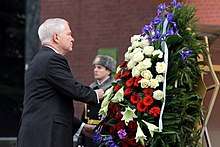
The Department of State Protocol of the Russian Foreign Ministry is responsible for organizing the itinerary for state visits to the country. It was founded on December 18, 1991, by Decree No. 291 of President Boris Yeltsin on the basis of the Foreign Policy Service of the RSFSR. The decree, in effect, provided a new unified protocol practice in the Russian Federation.[40] Its duties range from organizing invitations to the country to developing an event schedule for the dignitary's visit. Common practices organized by the department include protocol events meetings, wreath-laying, breakfast, and lunch, among others. The Presidential Protocol Office in the Presidential Administration of the Russian Federation also serves a similar purpose.[41]
A foreign head of state or government receives arrival honours from the 154th Preobrazhensky Independent Commandant's Regiment and the Special Exemplary Military Band upon their arrival at the VIP terminal at Vnukovo International Airport in Moscow, where they are usually greeted by the Russian Deputy Foreign Minister. Heads of State also take part in a welcoming ceremony with the President of Russia in the Hall of the Order of St. George of the Grand Kremlin Palace.
The following is Estonian diplomat Tiit Matsulevitš's opinion on Russian protocol for state visits:
"Russian diplomacy has a centuries-old tradition, I consider the Russian protocol to be one of the best in the world. The protocol service of Russia is very correct."[42]
— Tiit Matsulevitš, Estonian Ambassador to Russia from 1999–2001
Spain
.jpg)
State visits to the Kingdom of Spain are held with the participation of the King and Queen of Spain. The day's events begin as the visiting dignitary arrives in a special vehicle at the Palacio Real in the Spanish capital of Madrid. As the dignitary arrives, units of the Spanish Royal Guard (including the Mounted Band of Timpani and Bugles and the Lancers Troop) prepares for the start of the arrival ceremony. The ceremony starts with all units presenting arms at the sound of a bugle call and performing a royal salute, with the playing of the guest anthem and the Marcha Real taking place. Once the regiment is orders arms, 3 senior officers from the guard (a senior commander, a bugler and a guidon bearer) approach the central grandstand to report to the guest and His Majesty the king on the readiness of the regiment for inspection. They then begin their inspection, reviewing the infantry as well as the mounted units. Once the review is complete, a large military parade in the forecourt of the palace is held with the massed bands playing military music as the units march past.
The other notable state ceremony that takes place in the palace is the state dinner, which is hosted by the King, and is attended by the visiting dignitary, his/her delegation, the Spanish Royal Family, the Spanish Prime Minister, and other government officials. During the course of the visit, the visiting leader may deliver an address to a joint session of the bicameral Cortes Generales (composed of the Senate and the Congress of Deputies).
Ukraine
State visits to Ukraine are managed by the Main Department on State Protocol and Ceremonies of the Office of the President of Ukraine as well as the State Protocol Department of the Ministry of Foreign Affairs. State visits involve the President of Ukraine, the Chairman of the Verkhovna Rada, and the Prime Minister of Ukraine. Heads of state are met at the Boryspil International Airport, during which they are met by children in Ukrainian national costumes handing them bread. after which they are driven to the Mariyinsky Palace to receive a guard of honour from the Kyiv Presidential Honor Guard Battalion.[43] The battalion band performs national anthems of both countries, during which a 21-gun artillery salute. As the guest bows his/her head to the State Flag of Ukraine, they greet the honor guard with the battle cry of Glory to Ukraine (the official greeting of the Armed Forces of Ukraine[44]). After the ceremony, negotiations and a working breakfast/lunch are arranged in honor of the guest. In Kiev, there is a tradition of laying wreaths at the Tomb of the Unknown Soldier, the ceremony of which is as follows: a march of the three man team carrying a wreath through the Alley of Glory, wreath laying in front of the eternal flame, performance of national anthems, a march past of a guard of honour. On the first day of the visit, as a rule, a public dinner is held on behalf of the President of Ukraine in honor of the head of state in the Red Hall. At the end of the state dinner, a concert of musicians is held in the White Hall. Protocol stipulates that a state visit lasts longer (3-4 days) than an official visit (2-3 days).[45]
United Arab Emirates
The United Arab Emirates Air Force does a flyover while painting the sky in the colors of the visiting country's flag as the leader's car arrives at the Presidential palace with an Army mounted escort. Upon arrival, he/she is greeted by the President of the UAE and/or Deputy Supreme Commander of the United Arab Emirates Armed Forces, where they both receive military honors from the UAE Presidential Guard as well as a 21-gun salute from members of the Army. While inside the palace they are also greeted by children holding UAE flags as well as flags of the visiting country. The entire city of Abu Dhabi is usually decorated for the visit, with flags being laid out in the streets and large pictures of the leaders of the visiting country and the UAE being put on large buildings. During the visit of Vladimir Putin in October 2019, police cars were sprayed with the Cyrillic letters "ДПС", which stands for the "Дорожно-патрульная служба" (English: Roads Patrol Service).[46][47]
United Kingdom
.jpg)
A state visit to the United Kingdom is a royal event which involves the Queen and other members of the Royal family. An arrival ceremony usually takes place on Horse Guards Parade (There are also some instances where it takes place at Buckingham Palace or Windsor Castle) with a Guard of Honour being provided by members of the Queen's Guard. The guard of honour will always report to the dignitary in the language of the visitor, with the report being along the lines of the following:
- '"Your Excellency, the guard of honour, provided by the (states name of unit), is formed up, and ready for inspection."
Depending on the area where the ceremony takes place, a march past will immediately take place following the inspection. The foreign guest and the Queen then travel to Buckingham Palace in a carriage procession escorted by a large number of mounted soldiers from the Household Cavalry. The welcome ceremony is accompanied by 21-gun salutes fired from Green Park and the Tower of London. Around 150 guests are invited to Buckingham Palace for the state banquet in the evening in the ballroom.[48][49]
State visits do not formally occur between the United Kingdom and the 15 other Commonwealth realms, as the realms all share a common monarch and head of state. Visits conducted by the monarch to another Commonwealth realm is also not considered a state visits. Tours of other Commonwealth realms by the Monarch are conducted in their capacity as the monarch of that respective realm, and not as the British monarch. As a result, visits to other the Commonwealth realms by the United Kingdom are typically conducted as official visits by the Prime Minister of the United Kingdom. Conversely, official visits to the United Kingdom by another Commonwealth realm is typically performed by their respective governor-general, or prime minister.
United States

State visits to Washington, D.C. only occur on the invitation of the President of the United States in their position as head of state and head of the Federal government of the United States. Official visits refer to a visit by a head of government to Washington. During state visits, there are usually many events taking place in the capital, with the participation of hundreds of individuals. The first state visit took place in 1874 by Kalākaua of the Kingdom of Hawaii, followed by Pedro II of Brazil in 1876.
Events can range from a flight line ceremony at Joint Base Andrews, an arrival ceremony (either at the White House or The Pentagon depending on the guest), a State Department luncheon, a state dinner and an Address to the Congress.
See also
References
- "State and Guest of Government visits - April to October 2016 - Publications - GOV.UK".
- Moffett, Julie (9 August 1997). "World: How The U.S. Ranks the Visits of Foreign Heads of State". Radio Free Europe. Retrieved 3 June 2019.
- Campbell, Sophie (11 May 2012). "Queen's Diamond Jubilee: sixty years of royal tours". The Telegraph (Online edition). Retrieved 23 September 2016.
- Kinzer, Stephen (2008). Crescent and star: Turkey between two worlds. New York: Farrar, Straus and Giroux. p. 91. ISBN 9780374531409.
- "Office of Protocol of Canada". Global Affairs Canada. Government of Canada. 21 August 2018. Retrieved 11 February 2019.
- "Governors General representing Canada at home and abroad". Governor General of Canada. Office of the Governor General of Canada. 2019. Retrieved 10 February 2019.
- "Opinion: New welcome ceremony, China's new image". CGTN. Retrieved 25 September 2018.
- https://m.youtube.com/watch?v=HEFQ5JOiNlY
- https://www.historisches-lexikon-bayerns.de/Lexikon/Staatsbesuche_(nach_1945)
- http://www.bundespraesident.de/DE/Amt-und-Aufgaben/Wirken-im-Ausland/Staatsbesuche/staatsbesuche-node.html
- https://www.rferl.org/a/merkel-urges-moldova-to-speed-up-reform-pace/30058617.html
- "Pooja Thakur makes history - NATIONAL". The Hindu. Retrieved 25 September 2018.
- https://mod.gov.in/dod/ceremonials
- http://www.difesa.it/Il_Ministro/Uffici_diretta_collaborazione/Ufficio_Cerimoniale/Pagine/default.aspx
- "The Invitation Program of Japan". the Ministry of Foreign Affairs of Japan. 30 July 2014. Retrieved 26 May 2019.
- Examples: guard of honor, the performance of national anthem
- The head of state
- Another accommodation may be chosen.
- Both the Emperor and the Empress attend.
- The head of government, or a relative of a head of state
- The Empress attends when the visitor attends with a spouse.
- The visitor acts practically and officially.
- The visitor acts practically and unofficially.
- It depends on the visitors.
- A minister or a head of major international organization
- http://cbd.minjust.gov.kg/act/view/ru-ru/126?cl=ky-kg
- "Кыргыз Республикасынын Мамлекеттик протоколу жөнүндө". ud.gov.kg. Retrieved 25 September 2018.
- http://politicayprotocolo.com/2017/10/08/poder-y-protocolo/
- https://www.mfa.gov.md/en/content/visits-republic-moldova
- Dae-jung, Kim (20 June 2018). Conscience in Action: The Autobiography of Kim Dae-jung. Springer. ISBN 9789811076237.
- http://m.koreatimes.co.kr/pages/article.amp.asp?newsIdx=258239
- http://www.thestandard.com.hk/breaking-news.php?id=114200&sid=6
- https://www.nknews.org/2019/06/confirmed-north-korea-rapidly-built-xis-new-guesthouse-from-february-to-may/
- http://m.koreaherald.com/amp/view.php?ud=20180918000509
- "North and South Korean leaders hug ahead of summit". newsweek.com. 18 September 2018.
- https://www-m.cnn.com/2019/06/20/asia/xi-kim-north-korea-china-intl-hnk/index.html?r=https%3A%2F%2Fwww.google.com%2F
- "North Korea lecture at Kim Il Sung University by President of Mongolia Tsakhiagiin Elbegdorj".
- https://www.royalcourt.no/seksjon.html?tid=102526&sek=102525
- http://www.president.pl/en/presidential-residences/presidential-palace/
- "Соглашение о создании Содружества Независимых Государства". Исполнительный комитет СНГ. Archived from the original on 21 July 2006. Retrieved 14 January 2008.
- http://en.kremlin.ru/structure/administration/departments#department-1016
- http://www.moles.ee/06/Feb/22/4-1.php
- zakon.rada.gov.ua https://zakon.rada.gov.ua/laws/show/746/2002. Retrieved 20 April 2020. Missing or empty
|title=(help) - Poroshenko, Petro. "President: The words "Glory to Ukraine! Glory to the Heroes!" will be the official greetings of the Armed Forces of our state". PRESIDENT OF UKRAINE Official website. Government of Ukraine. Retrieved 11 August 2018.
- "ПРОТОКОЛЬНЕ ЗАБЕЗПЕЧЕННЯ ВІЗИТІВ НА ВИЩОМУ РІВНІ". Pidruchniki. Retrieved 20 April 2020.
- https://m.gazeta.ru/politics/2019/10/17_a_12760394.shtml
- https://ria.ru/amp/20191016/1559845273.html
- "State Visits | The Royal Family". royal.uk. Retrieved 25 September 2018.
- "Changing the Guard | Ceremonial Events / State Visits". changing-guard.com. Retrieved 25 September 2018.
External links
![]()
- Visits by Foreign Leaders – Organized by the Office of the Historian of the United States Department of State; lists visits by year and by country, including names of the visiting leader and a brief description of the visit
- REFEED: Putin begins state visit to UAE
- FULL VIDEO: Queen Elizabeth II hosts welcoming ceremony for Chinese President Xi Jinping
